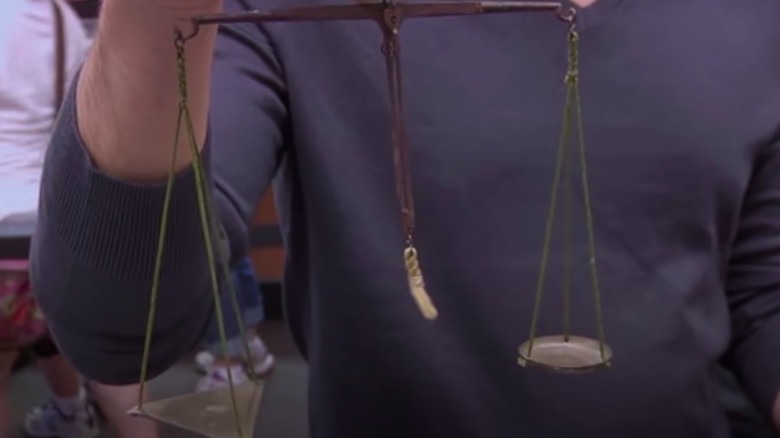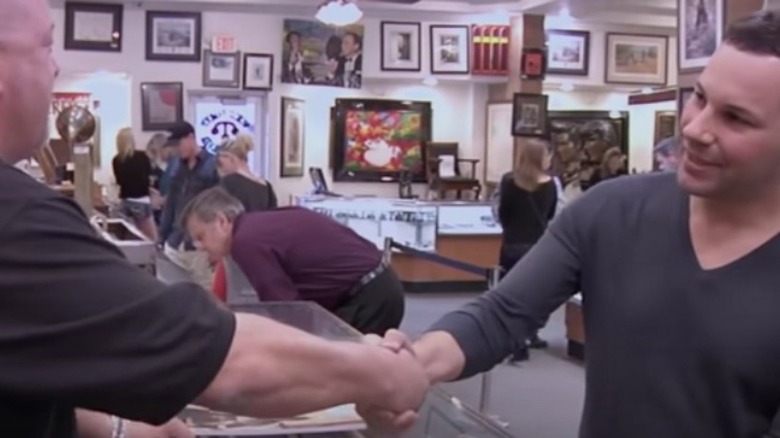The 300-Year-Old Scale That Sold For Thousands On Pawn Stars
On History's "Pawn Stars," some items that pass through the Gold & Silver Pawn Shop are so rare, the average person might not be aware of what they're worth. A seller named Adam knew exactly what he had, though, when he came in with a 17th century Dutch balance scale.
Opening the case, he showed Rick how it worked, using small, marked weights to measure the weight of coins. Adam said he believed the government marked the weights to assure they were proper measurements. A date on the set, 1662, proved just how rare it was. "It's very, very unusual to find them from the mid-17th century," he pointed out.
Rick liked the item right away and proved he knew all about Dutch scales, too, offering up his own expertise. "International trade really blew up in the 1600s. And the Dutch were like the biggest player in that game. They had trading posts all over the world," he said. "So having a little portable scale like this to deal with different kinds of foreign money was extremely useful, especially if you didn't want to get ripped off."
Both Rick and the seller appreciated the inherent significance of the piece. But when Adam named his asking price, $4,000 (a grand over his minimum), Rick knew he needed more information and called in an expert to help determine the scale's modern-day monetary value.
"This thing is really nicely crafted and it's in great shape for being 300 years old. If it's truly authentic, it's worth some money and it would be a great addition to the shop... If everything checks out, we'll talk about price," he promised.
An expert weighed in
Clark County Museum Administrator Mark was happy to examine the scale and verify its authenticity –- if he could. "Anything that's collectable can and probably has been faked, so it makes perfect sense to check, just to be sure," he said.
In fact, the scale itself was designed to prevent a con. As Mark explained, there were lots of coins circulating in 300 years ago, and clipping coins was a concern for merchants as well as a capital offense for those who committed the crime. "You could be hanged for that. You could be drawn and quartered for that. So scales like this were extremely important," he said. "In the 17th century, if you were in a position in a business where you were actually handling money, you had somebody who had a coin scale, so that you could check every single coin that came in."
Looking over the item, Mark observed that certain parts of the scale — like the strings — had been replaced. But other elements, including the engravings and the manufacturing type, were spot on for a scale from the 17th century. His conclusion: "Yes, this is a 1662 coin scale."
It was good news for Adam, but Rick still needed to work out a deal he felt was profitable.
Negotiations started low
Rick started off with a lowball offer of $1,500. From the look on his face, he didn't expect Adam to bite, and it was no surprise when the seller turned him down. "It's honestly too low," Adam said. "They sell some of these weights individually at a lot of money, and I really don't want to go less than $3,000."
Rick was quick to point out that the item would be hard to sell and also had a few issues with its condition. When he came back with $2,500, Adam hesitated. He'd given away his minimum early in the game, and now it looked as if that was going to cost him.
In the end, however, he agreed to take the offer. Hopefully, Adam was as pleased as Rick. "I'm really glad this deal worked out. The scale's a pretty unique item and it looks cool," Rick said. "Even though it might take a while to find the right buyer for it, in the end, it should bring a nice profit."


